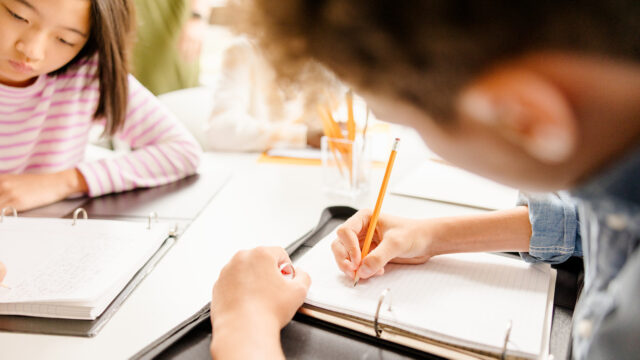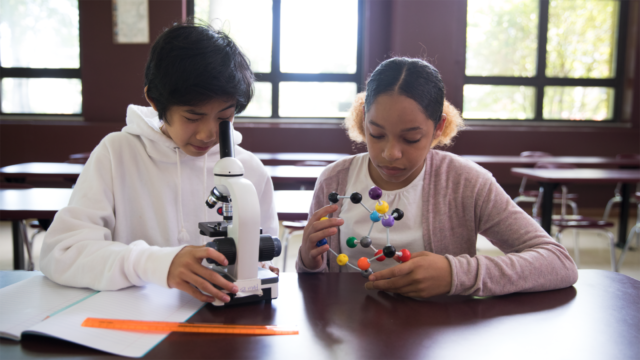
Image: The 9/11 Memorial in lower Manhattan was built to honor the victims of the 2001 attacks on the World Trade Center. (Jin S. Lee, 9/11 Memorial and Museum)
On September 11, 2001, nearly 3,000 people were killed in a series of attacks in the United States. Two hijacked airplanes flew into the World Trade Center in New York City, causing the towers to collapse later in the day. Another flew into the Pentagon (U.S. military headquarters) in Arlington, Virginia. A fourth hijacked plane, possibly bound for the U.S. Capitol or the White House, crashed into a field in Pennsylvania after passengers and crew attempted to overtake the terrorists. The attacks were carried out by the militant group al-Qaeda.
9/11 Lesson Plans for Elementary
For most adults, these events are etched in our brains. But students today are too young to remember the attacks. So you'll have to decide how much to share with them. You might choose to discuss the terror attacks and their impact, or simply deliver a lesson on heroism. (Follow these guidelines for talking with young people about terrorism in the classroom.)
Whatever you decide, our 9/11 activities for elementary students have got you covered. (Teaching the upper grades? Here are 9/11 activities and lesson plans for middle and high school students.) Be sure to review all resources before sharing them with students as the events are disturbing.
1. Do a Read-Aloud
Here are six books that will give students a sense of how people helped in the wake of the 9/11 attacks and how Americans healed. The links below lead to video book trailers, activity sheets, discussion starters, and teachers' guides featuring cross-curricular activities. Here are free graphic organizers that students can use for note-taking as they listen to the stories or read them on their own.
- 14 Cows for America by Carmen Agra Deedy (Pre-K–3)
- Branches of Hope by Ann MaGee (Pre-K–2)
- 30,000 Stitches by Amanda Davis (Grades K–3)
- America Is Under Attack by Don Brown (Grades 1–5)
- Fireboat: The Heroic Adventures of the John J. Harvey by Maira Kalman (Grades 3–5)
- Nine, Ten: A September 11 Story by Nora Raleigh Baskin (Grades 3–8)

2. Hear First-Person Accounts
Every year, the September 11 Memorial & Museum shares a film featuring first-person accounts of the attacks that can be viewed in the classroom to start a discussion on this difficult topic. The program will be interpreted in American Sign Language, captioned, and can be played with Spanish subtitles. You can sign your class up for an interactive live chat where students can pose questions to museum staff. Past videos included a firefighter who responded to the World Trade Center on 9/11; a police officer who was rescued from the debris at Ground Zero; and a student who attended the Florida elementary school where President George W. Bush was first informed of the 9/11 attacks. There is an option for teachers to preview the content before sharing the video.
After watching the video, hold a class discussion using guided questions, such as:
- What did you learn about 9/11 from the person’s story?
- Why do you think the 9/11 Museum took a video of people talking about their experience on September 11?
- How do first-person accounts help us learn about history?
- What questions do you still have after hearing the person’s story?
3. Conduct an Interview
Tell students that primary documents make history come alive. Here’s how to teach students about primary sources and why they are important. Make sure students understand the difference between primary and secondary sources.
Next, explain to students that they are going to interview an adult about their memories of 9/11. Once they know who they will interview, they should decide if the person is a primary source or secondary source. Tell them to do an audio or video recording of the interview. Brainstorm with students a list of questions they might ask, such as:
- What do you remember about the 9/11 terror attacks?
- How has the world changed as a result of 9/11?
Afterwards, have students write a paragraph describing what they learned about 9/11 and its impact. This blog on how to write expository paragraphs can guide them. Finally, invite students to share their reflections with the class.
4. Make Paper Cranes
Tell students that in Japan, origami paper cranes are a symbol of healing. After the terror attacks in New York City, people left paper cranes at the fence near Ground Zero. Those cranes, along with thousands of others donated by Japanese students, have been added to the 9/11 Memorial and Museum. After a devastating tsunami struck Japan in 2011, the 9/11 Families' Association gifted the country an origami crane melded from steel recovered from the World Trade Center, as a symbol of hope in the face of disaster.
Encourage students to learn more about the history of origami paper cranes. They can also try their hand at making the cranes by following these step-by-step directions. Japanese legend has it that if you fold 1,000 origami cranes you'll be granted a wish. Challenge students to work together to create 1,000 cranes to display in your classroom or school hallway, along with messages of hope for the future. Alternatively, the cranes could be donated to a local hospital, nursing home, or community center.

5. Thank a Hero
Start a discussion about heroes. Ask: What makes a real-life hero? What are their character traits? Who are your heroes? Why?
Tell students that on 9/11 many people acted heroically, from firefighters to police officers to office workers and passersby. They helped to save people's lives. Brainstorm with your class a list of people—firefighters, police officers, EMTs, doctors, nurses, and crossing guards, for example—who keep the community safe. Then have students think of a good way to thank them. They may want to write a thank-you letter, poem, or rap. (Here's a video lesson on how to write a rap). Or they may want to design a digital show of appreciation using Tinkercad, Sketchbook, or another free art app.
Older elementary students can research individuals who acted heroically during the attacks of September 11, 2001. They might choose one of the following: Firefighter John "Jay" Jonas, Port Authority officer David Lim, EMT Mercedes Rivera, NYPD chief Terri Tobin, or tax auditor Rose Riso, who worked in the south tower of the World Trade Center. Challenge students to work in pairs or groups to create a video spotlighting the person's heroism.
6. Design a Tribute
Show students images of 9/11 memorials. The 93-foot Tower of Voices in Shanksville, Pennsylvania, holds 40 wind chimes to honor the 40 passengers and crew members who died when one of the hijacked planes crashed in a field there. The National Park Service site also has a video so students can hear the chimes, representing the voices of those who died. At the Pentagon in Washington, D.C., 184 memorial benches were built in remembrance of each victim of the attacks. The benches are organized in a timeline of the victims' ages, from the youngest, 3-year-old Dana Falkenberg, to the oldest, 71-year-old John Yamnicky. In a ceremony in New York City, the names of all 2,983 people killed on 9/11 are read aloud each year on the anniversary of 9/11 and a Tribute in Light shines two beams symbolizing the Twin Towers four miles into the sky above Manhattan from dusk on September 11 to dawn on September 12.
Point out that the tributes are symbolic. The wind chimes represent the voices of those who died on the plane that crashed in a Pennsylvania field. The two beams of light represent the Twin Towers. Remind them that symbols may already be familiar to them. Ask: What is a symbol for love? (heart) What is a symbol for hope? (rainbow) What is a symbol for peace? (dove, peace symbol)
Challenge students to create their own symbolic tribute to the victims of 9/11. Ask: What do you wish for those affected by 9/11? Make a list of student responses. Students might say peace, hope, happiness, or resilience. Then challenge them to come up with a way to represent that wish in a three-dimensional artwork. Students might use clay or found objects like stones, shells, newspaper clippings, photographs, fabric, and the like.
Share Your 9/11 Lesson Plans
How do you teach the events of September 11 in your elementary classroom? Do you have sensitive ways of addressing the attacks with young students? We’d love to hear your ideas. Share your 9/11 lesson plans with us at Shaped@hmhco.com.
***
Give your students the chance to act like historians and develop their analytical skills with HMH Into Social Studies. This dynamic program includes engaging digital magazines and hands-on activities that will captivate your class.
Discover more lesson plans and classroom resources on Shaped.
Download our FREE calendar of activities!














